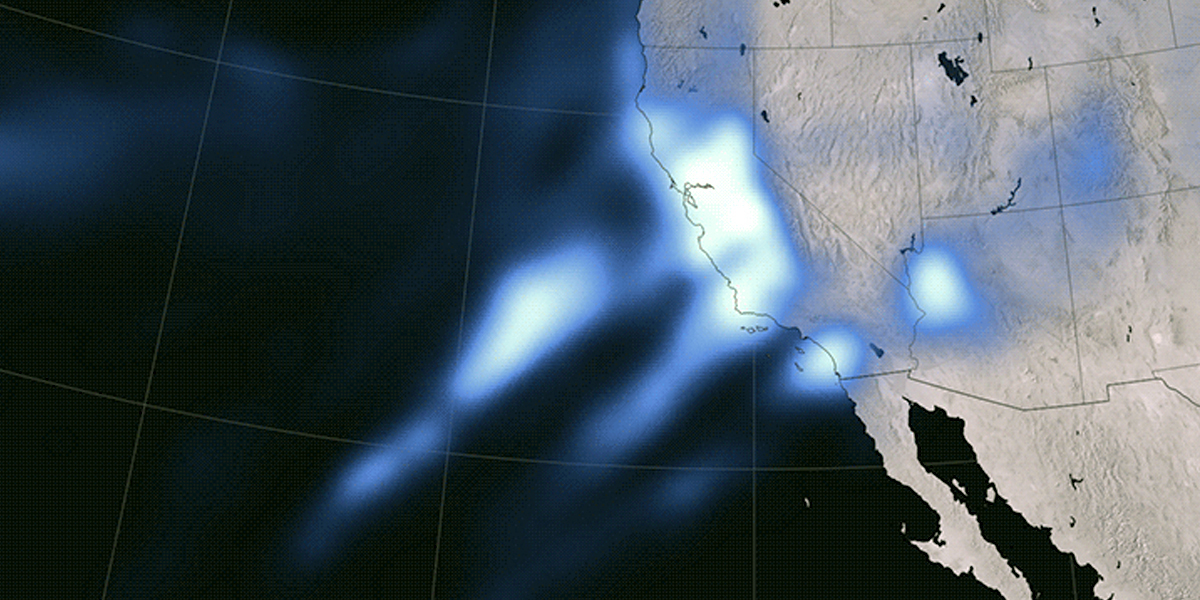
San Francisco Receives More Rain in First Eight Days of January Than All of 2013

Extreme weather, from drought to heavy downpour, lambasted much of California over the last couple of weeks.
An atmospheric river brimming with moisture, known as the “Pineapple Express,” brought tropical Hawaiian water to California with some of the worst flooding since 2005. The river can carry up to 15 times the equivalent volume of the Mississippi River. According to NASA, “Between 30 and 50 percent of the annual precipitation in the western U.S. comes from just a few atmospheric river events.”

More than 350 billion gallons of water poured into Northern California reservoirs last week. Reservoirs from Mount Shasta to Lake Tahoe filled faster than any time since 1922. Lake Shasta is the state’s largest reservoir, a crucial water source enabling agriculture in the otherwise dry San Joaquin Valley. Lake Shasta is now 82 percent full.
Fifteen feet of snow fell on Mammoth Mountain in the eastern Sierras from Jan. 6 to 11. Kirkwood Ski Resort added 11 feet of snow in five days. Since Oct. 1, precipitation in the Sierra Nevada has been on pace with 1982-83, northern and central Sierra, and 1968-69, southern Sierra, as the wettest winters on record in modern times.
With the extreme rainfall came deadly mudslides, torrential flooding and hurricane-force winds. Thousands of people were forced to evacuate their homes. At least four fatalities are linked to rain, snow, mudslides and flooding.
Squaw Valley Ski Resort in Olympic Valley recorded a record-breaking 173-mph wind gust at its 8,700-foot peak. That’s equivalent to a Category 5 hurricane, which rips buildings off their foundations.
The National Weather Service reported a tornado that tore through the community of South Natomas in the state’s capitol Sacramento. It left a half-mile swath of destruction, shredding trees, and leveling metal awnings and a fence.
Though rainfall from December to late February is the normal pattern, San Francisco received more rain in the first eight days of January than it did during all of 2013.
“What’s happening in the Bay Area is unusual,” Tom Fisher, weather specialist for the National Weather Service in Oxnard, told the Los Angeles Times.
Heavy rains and winds in northern California took their toll in Calaveras Big Tree State Park, 90 miles east of Sacramento. A giant Sequoia named “Tunnel Tree” lost its footing and came crashing to the Earth.
More than 40 percent of the state is no longer in drought, according to the U.S. Drought Monitor. Most of that area accounts for Northern California and the Sierra Nevada.
Despite the staggering amounts of precipitation from the Pineapple Express, parts of Southern California received no measurable rainfall. As a result, those drought stricken areas doubled from 18 percent to almost 35 percent.
10 #Satellite Images Show How #California’s Reservoirs Are Drying Up https://t.co/0EgVX0PrZO #Drought @lakepedia @Waterkeeper @acousteau
— EcoWatch (@EcoWatch) November 6, 2016
“The drought has not let up on the Central Coast,” said David Matson, assistant general manager of the Goleta Water District.
Los Angeles and Orange Counties along with parts of central California are officially still experiencing “extreme drought.” While Ventura and Santa Barbara Counties remain in “exceptional drought.” Santa Barbara’s Lake Cachuma added a meager 3 percent to its water levels, which is only 11 percent full.
With more precipitation forecasted for next week, water-starved Southern California could get a reprieve.
More moisture will also help California’s parched forests. Over the last five years, 102 million trees have died from water starvation and bark beetle infestations.
102 million trees have died in California's drought, according to new report: https://t.co/bpq3Y0iNFQ via @EcoWatch
— NRDC 🌎🏡 (@NRDC) November 25, 2016

 233k
233k  41k
41k  Subscribe
Subscribe 